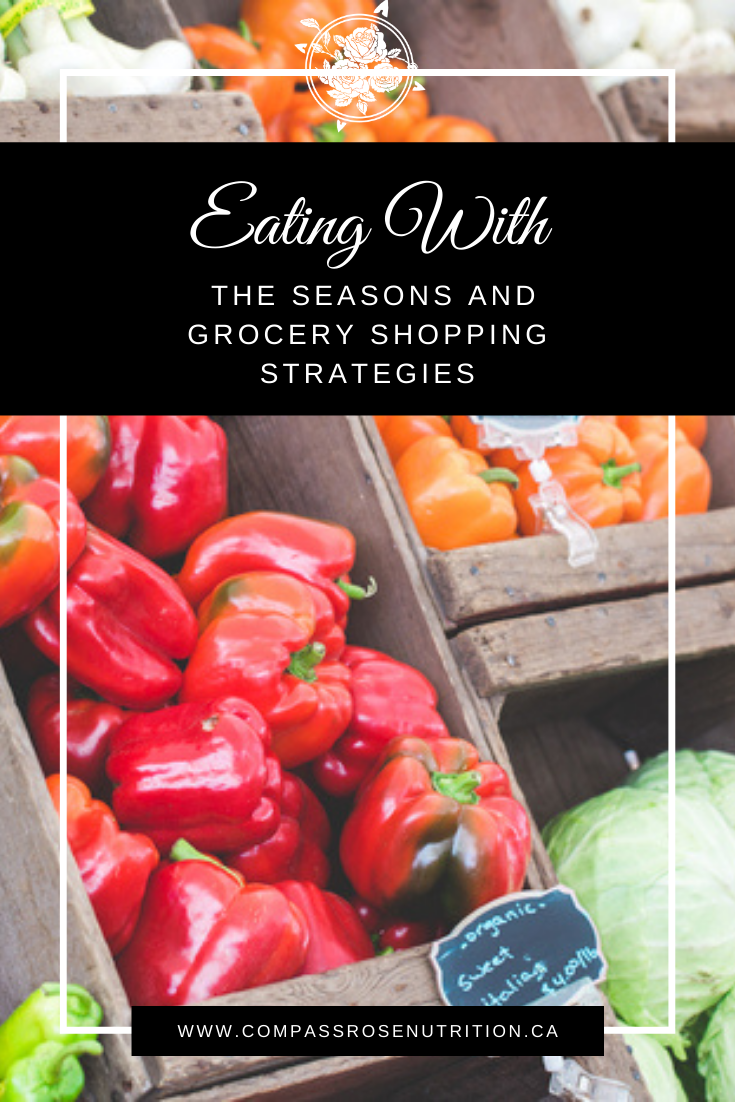Are you eating and grocery shopping for foods that are in season?
Have you ever tried buying summer fruits in the middle of winter? If you have, then you know how expensive and tasteless they can be. Eating produce in season is so much better for your health, wallet, and the planet. Here are some great tips on how you can eat foods that are in season and how to shop for these foods.
One of the easiest ways to know what’s in season is to buy your groceries or fresh produce at a local farmer’s market. Not only are you supporting your local farmers, but you are also getting the freshest produce possible. Your fruits and veggies aren’t going through days of transportation and sitting in huge warehouses like they would at the big grocery stores. Buying local is also beneficial for the environment. Your produce doesn’t need to be transported, so you are reducing your carbon footprint. If you have a yard, you can even plant a few of your own fruits and veggies.
The fruits and veggies in season will depend on where you live. Typically, apples, root vegetables, and starchy vegetables such as butternut squash, potatoes, and pumpkin, are in season in the fall and winter. In the summer, you have many more options for fresh produce. Berries, cucumbers, peaches, watermelon, and tomatoes all grow in the summer months. Doing a quick search on the internet will tell you what specific foods are in season where you live. Write down a list and take it with you when you are food shopping.
some benefits of eating with the seasons and learn effective grocery shopping strategies
Find new recipes and plan ahead.
Eating with the seasons can feel overwhelming when you first start, and you might feel limited with your food options. Research some new recipes that you can try out with your seasonal produce. Soon you’ll find that you’re actually getting more creative with your meals and trying produce that you may have never tried before. Eating seasonally during the winter months can be more difficult, but remember that not all your food has to be consumed fresh. Most summer fruits, such as berries, peaches, and many more freeze very well. You can also pickle many vegetables.
Eating with the seasons is economical, better for the environment, and supports local farmers, and it’s also better for you too. It is the easiest way to save money on your grocery bill because produce that’s in season is always more inexpensive. Also, fruits and veggies that are in season don’t need to be sprayed with preservatives or waxed to keep fresh. If you’ve ever tried produce that’s not in season, you know that it usually lacks flavor.
Transporting produce across the country is complicated, and suppliers need to prioritize a long shelf life. That usually means involving genetic modification, hormones, and preservatives. Unfortunately, this modification affects the flavor as well as the nutritional value of your food.
Eating with the seasons can help you make more health conscious with your food choices, which can help with eating more mindfully. Eating varieties of food is recommended because it’s the easiest and healthiest way to get all of the vitamins and minerals that your body needs. So next time you go on a grocery run, pick up some in season items and enjoy the bursts of flavor.
If you don’t come prepared, grocery shopping can feel overwhelming and can take up a considerable chunk of your time. Not to mention, there is no worse feeling than coming home from the store only to realize that you really didn’t buy anything you needed. A little organization helps to make sure you can make the most out of your grocery trips. Here are some strategies to make your next grocery trip stress-free and more efficient.
Make a list.
If you only take one strategy from this, it should be this one! Making a list is a guaranteed method for buying everything you need and staying on track. No more forgetting what you came for! It also helps if you organize your list into sections of the grocery store, such as fresh produce, meat, dairy, dried goods, and freezer items. This way, you’ll find items on your list more easily when you’re in that specific section, so you won’t have to keep running back and forth.
Plan your meals for the week.
You don’t need to have an exact schedule, but you should have a rough idea of what meals you plan to make. That way, you will go to the grocery store knowing what you intend to use each ingredient for. You can save lots of money and prevent food waste because your groceries will no longer sit in your fridge waiting to be eaten. This strategy will also keep you organized so that you don’t have to stress about what meals you’re making for dinner during your busy week. And no more forgetting that one ingredient because it was on your grocery list already!
Check flyers beforehand to see what’s on sale.
Looking for discounted items when you’re already at the grocery store can be confusing and time-consuming. The sale stickers might also tempt you to buy things that you don’t need just because they’re on sale. Stay away from those tricky sale signs. Instead, browse through the sale flyers before you go and note down anything that you need. This strategy will help you save money without costing you much time.
Note: Most stores put out their new sales flyers mid-week, but check your local grocery store.
Look out for best-before dates and pick the freshest produce possible.
When you buy fresh food, you won’t have to go to the grocery store as often because your food will last longer in your fridge. This will save you money and frustration because there is nothing worse than unpacking your groceries and noticing that there is already mold forming on your berries.
Don’t walk through the aisles that you don’t need.
Although it can be fun to scan the entire grocery store every time you go, this takes an incredibly long time and will lead you to buy things you don’t need. Stick to the parameter of the grocery store, which is where they place the healthy whole foods. Try only walking through the aisles if you know if you need something there.
Never shop on an empty stomach.
Food shopping when you’re hungry is a recipe for overspending. It’s best to eat before you go, but sometimes you’re in a rush or stopping at the store on your way home from work. In this case, always pack a snack and keep it in your bag for emergencies. Mixed nuts, granola, protein bars, and apples are ideal snacks because they don’t require any prep time or ice packs.
So before you go to the grocery store, take a minute and look at what you currently have. Do you need just produce (that you can get from the farmers market) or do need a whole list of items? If you have any more grocery shopping strategies that work for you, I would love to hear about them in the comment section below.
Looking for summer meals or recourses? Check out my Nutrition and Wellness Library.
Inside you will find meal plans, healthy recipes and so much more.
Click below and sign up - it’s free!




